Introduction
Some months ago, I pushed my first Android library to Github. UndoRecycler was its name, and it added some extra features to the RecyclerView.Adapterclass. It had a built-in OnItem(Long)ClickListener, headers, swipe to dismiss, and undo functionality. Sounds pretty convenient, right?
However, there were two major problems with UndoRecycler:
1) Although it did support both item and header elements, it didn’t really provide a way to use multiple viewtypes. It was possible, but the user had to do all the heavy lifting. Furthermore, the adapter would become a mess filled with if functions checking for every viewtype.
2) It did provide some useful features, but there was no way for a user to only select the features he wanted. the whole UndoAdapter class had to be extended, with all its mandatory and optional methods for each separate feature. Once again, a mess.
Architecture
Having accepted the fact that my library wasn’t so useful after all in its current state, I decided to try and improve it.
Level 1
The first problem I tackled, was the limited management of multiple viewtypes. The solution? Modular design! Instead of handling every viewtype inside of the same large adapter, each viewtype gets its own AdapterModule. When the adapter needs some work done for a certain viewtype, it just asks the corresponding module to do the work for him. Finding the corresponding module for a certain viewtype is handled by the library, so the only thing the user needs to do, is implement the modules by extending the AdapterModule class.
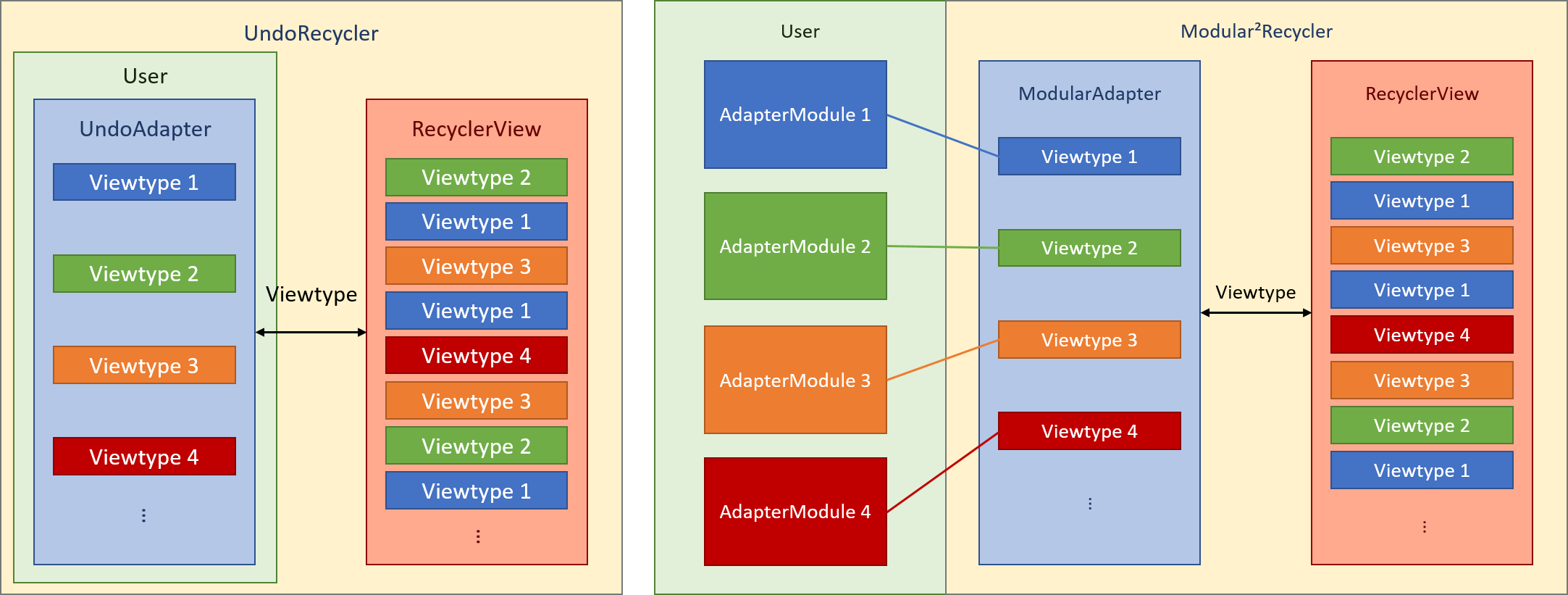
Figure 1: Side by side comparison of old and new architecture.
Level 2
Quite an improvement already, but the second problem still remains. Each module contains methods for every possible feature, even when they are not necessarily used. The solution? Modular design, again! It would be a lot easier if the modules could be composed of building blocks corresponding to the necessary features. And are we in luck, because Java offers these building blocks in the form of Interfaces. So let’s extract the methods for each feature into a corresponding interface and call it a plugin. We can now use the AdapterModule class as the fundament for our module and just plug in the desired plugins.

Figure 2: Modules are composed of plugins to add corresponding functionalities.
Modular²Recycler
Our adapter is now modular on two levels; it is modular squared! The UndoRecycler has turned into the Modular²Recycler.
Used patterns
The first level is not just modular, but the modules are also reusable. Level 1 implements the aggregation pattern. On the second level, the plugins can only be used in the module in which they were implemented. Level 2 implements the composition pattern.
Code
Now that we understand the architecture of the library, let’s take a look at what our code looks like when using it. If the architecture isn’t perfectly clear to you yet, don’t worry. The following examples will (hopefully) make everything clear. The code used in this section is based on the example app PokéApp, which is available both on Github and the Play Store.
Level 1
Let’s say we want to show the images and names of some pokemon in our RecyclerView. The only things we need, are a Pokemon class implementing ModularItem and a PokemonModule extending AdapterModule.
public class Pokemon implements ModularItem {
public String name;
public Drawable icon;
public boolean isHeader() {
return false;
}
}
public class PokemonModule extends AdapterModule<PokemonViewHolder, Pokemon> {
public PokemonModule(ModularAdapter adapter) {
super(adapter);
}
@Override
public PokemonViewHolder onCreateViewHolder(ViewGroup parent) {
View itemView = LayoutInflater.from(parent.getContext()).inflate(R.layout.recycler_row, parent, false);
return new PokemonViewHolder(itemView);
}
@Override
public void onBindViewHolder(PokemonViewHolder viewHolder, Pokemon pokemon) {
viewHolder.vText.setText(pokemon.name);
viewHolder.vIcon.setImageDrawable(pokemon.icon);
}
public static class PokemonViewHolder extends RecyclerView.ViewHolder {
public ImageView vIcon;
public TextView vText;
public PokemonViewHolder(View view) {
super(view);
vText = (TextView) view.findViewById(R.id.textView);
vIcon = (ImageView) view.findViewById(R.id.imageView);
}
}
}
Now we just need to instantiate our ModularAdapter and PokemonModule. This can be done from your Activity.
List<Pokemon> pokemonList = Pokedex.getAllPokemonAlphabetic();
// The adapter is built with a builder class (Not explained in this blog post).
adapter = new ModularAdapterBuilder(recyclerView, pokemonList)
.build();
new PokemonModule(adapter);
And voila, your RecyclerView is showing the names and images of your pokemon.
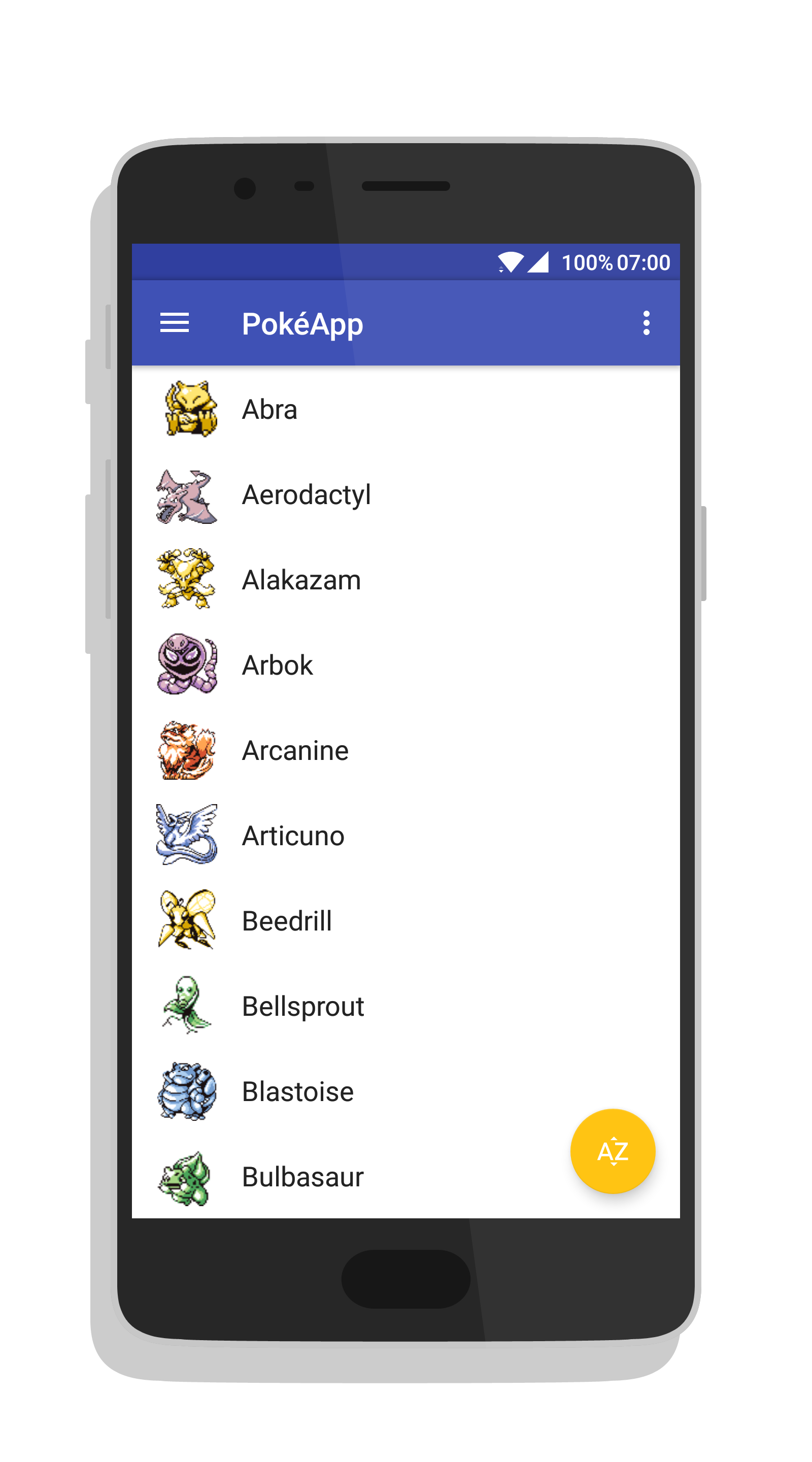
But now it’s just a long list of pokemon. A clear overview is missing. So lets fix that by adding in some headers. Again, let’s create a Header class implementing ModularItem and a HeaderModule extending AdapterModule. Now just return true in the isHeader() method of ModularItem in the Header class to make the adapter recognize it as a header.
public class Header implements ModularItem {
String name;
public Header(String name) {
this.name = name;
}
public boolean isHeader() {
// return true to make ModularAdapter recognize this as a header class.
return true;
}
}
class HeaderModule extends AdapterModule<HeaderModule.HeaderViewHolder, Header> {
HeaderModule(ModularAdapter adapter) {
super(adapter);
}
@Override
public HeaderViewHolder onCreateViewHolder(ViewGroup parent) {
View headerView = LayoutInflater.from(parent.getContext()).inflate(R.layout.recycler_header, parent, false);
return new HeaderViewHolder(headerView);
}
@Override
public void onBindViewHolder(HeaderViewHolder viewHolder, Header header) {
viewHolder.vText.setText(header.name);
}
static class HeaderViewHolder extends ViewHolder {
TextView vText;
HeaderViewHolder(View view) {
super(view);
vText = (TextView) view.findViewById(R.id.textView);
}
}
}
Add in some headers in the list you provide to the ModularAdapter (you could also insert them directly into the adapter) and instantiate your HeaderModule.
List<Pokemon> pokemonList = Pokedex.getAllPokemonAlphabetic();
List<ModularItem> list = addHeaders(pokemonList);
// The adapter is built with a builder class (Not explained in this blog post).
adapter = new ModularAdapterBuilder<>(recyclerView, pokemonList)
.build();
new PokemonModule(adapter);
new HeaderModule(adapter);
We now have a list of pokemon, divided by headers.
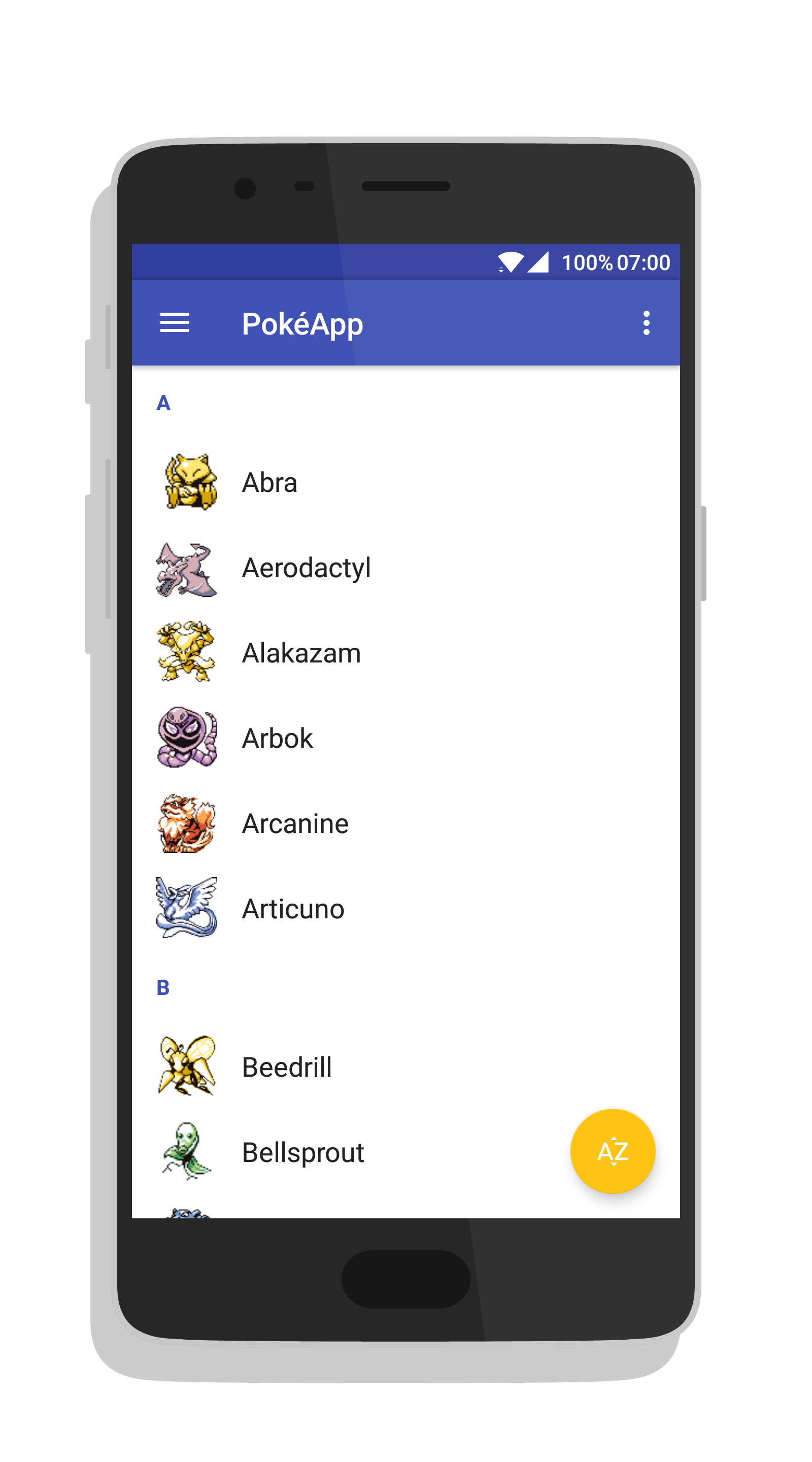
If you want to add some more viewtypes, just do the same again over and over. Want to add some digimon to spice it up? Create a Digimon class implementing ModularItem and a DigimonModule extending AdapterModule and add it to the adapter.
This code clearly shows that the modularity introduced at the first level makes for easy adding of new viewtypes and clean code.
Level 2
However, functionalities ar still lacking. So lets take our PokemonModule and expand its functionality by plugging in some plugins. What if we want to know when a pokemon was clicked? Just plug in an ItemClickPlugin!
public class PokemonModule extends AdapterModule<PokemonViewHolder, Pokemon>
implements ItemClickPlugin<Pokemon> {
...
// module code
...
@Override
public void onItemClicked(Pokemon pokemon) {
// pseudoCode
toast("Clicked " + pokemon.name + "!");
}
}
That’s it! Notice the argument of the onItemClicked method in the module. There is no need to find out which pokemon was clicked, since the ModularAdapter does this for you and hands in the clicked Pokemon instance as an argument.
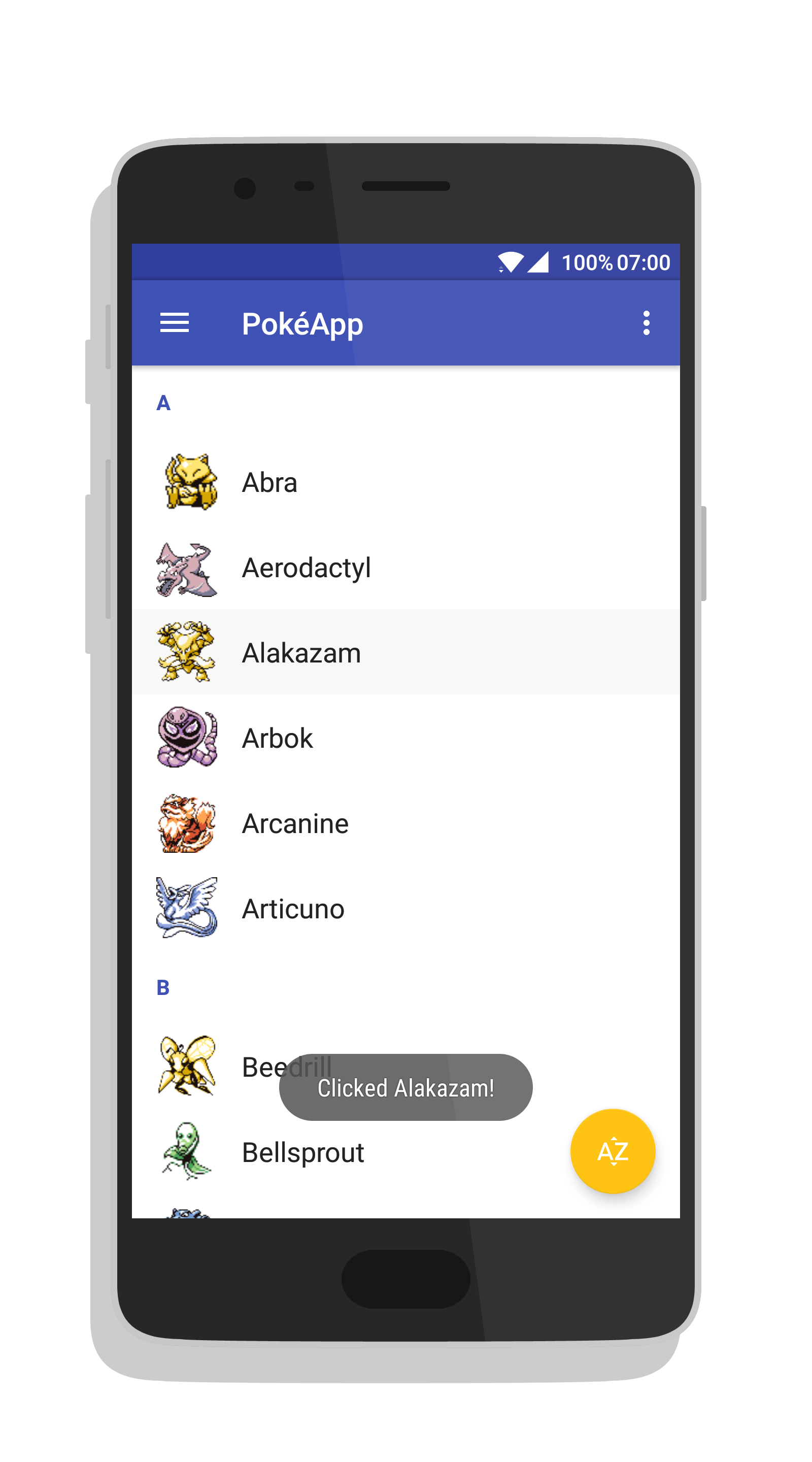
You want to add even more functionality to your item, like for instance an OnLongclickListener? (I know, adventurous, right! But it’s easiest to explain the concepts with the simplest functionalities). Just plug in an ItemLongClickPlugin.
public class PokemonModule extends AdapterModule<PokemonViewHolder, Pokemon>
implements ItemClickPlugin<Pokemon>, ItemLongClickPlugin<Pokemon> {
...
// module code
...
@Override
public void onItemClicked(Pokemon pokemon) {
// pseudoCode
toast("Clicked " + pokemon.name + "!");
}
@Override
public void onItemClicked(Pokemon pokemon) {
// pseudoCode
toast("Long clicked " + pokemon.name + "!");
}
}
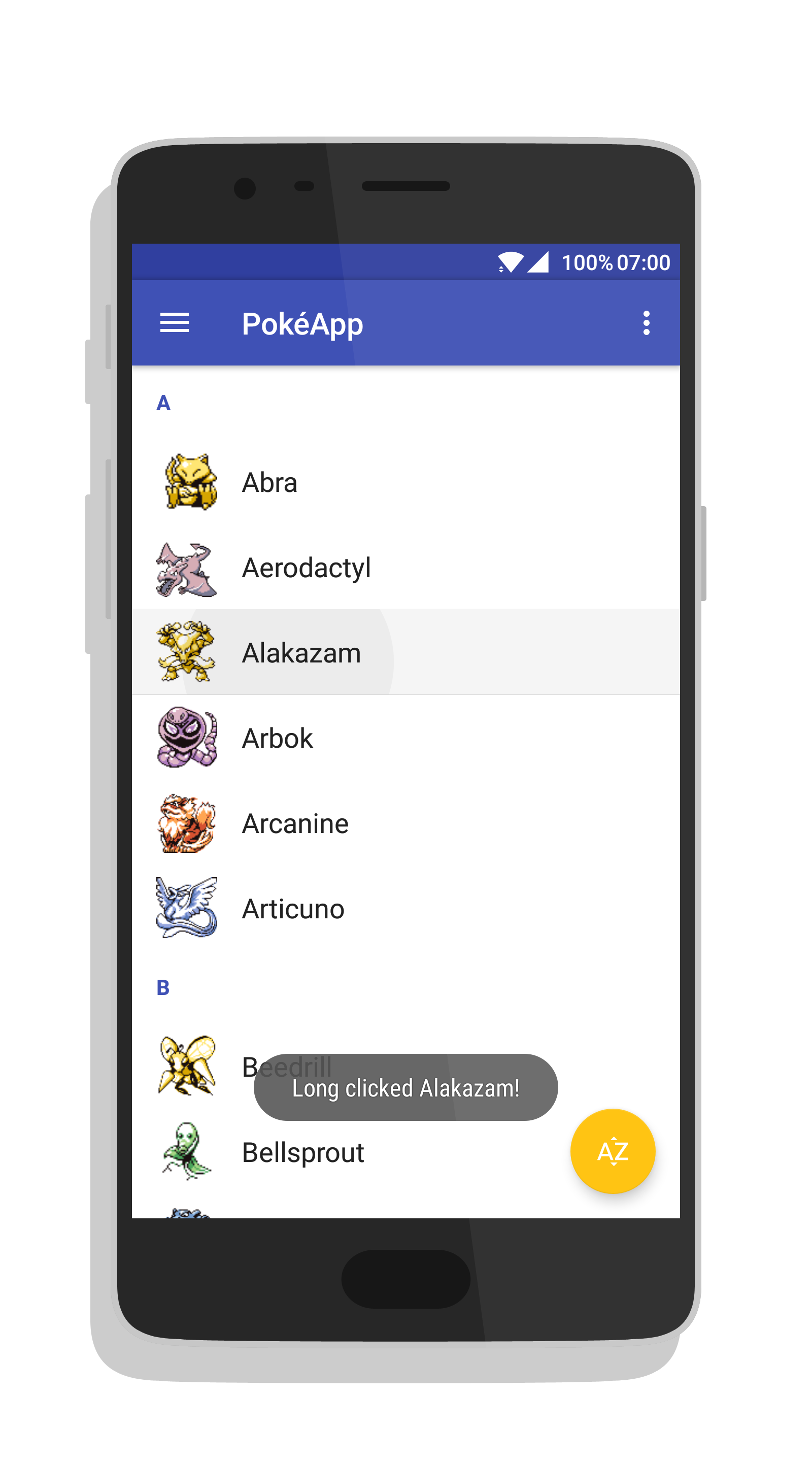
Other plugins
The SwipePlugin and DragAndDropPlugin are also available. They are a bit more complex, but are added in exactly the same way.
Conclusion
This blog post should give you enough information to start using the library. More hands on information is available on the project page on Github. I might write a blog post delving deeper into how ModularAdapter works under the hood if there is any interest.
Feedback
Any feedback is greatly appreciated. Just open up an issue, or send me an email.
Contributions
Any contribution is also greatly appreciated. Just open up an issue, send me an email, or submit a pull request.
One way to contribute is by implementing extra plugins.